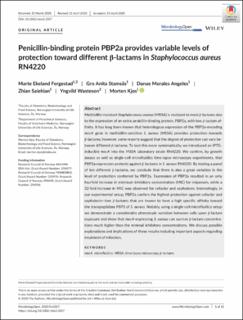| dc.contributor.author | Fergestad, Marte Ragnhild Ekeland | |
| dc.contributor.author | Stamsås, Gro Anita | |
| dc.contributor.author | Angeles, Dana Morales | |
| dc.contributor.author | Salehian, Zhian | |
| dc.contributor.author | Wasteson, Yngvild | |
| dc.contributor.author | Kjos, Morten | |
| dc.date.accessioned | 2021-05-07T08:18:58Z | |
| dc.date.available | 2021-05-07T08:18:58Z | |
| dc.date.created | 2020-12-17T15:45:41Z | |
| dc.date.issued | 2020 | |
| dc.identifier.citation | MicrobiologyOpen. 2020, 9 (8), e1057-?. | en_US |
| dc.identifier.issn | 2045-8827 | |
| dc.identifier.uri | https://hdl.handle.net/11250/2754085 | |
| dc.description.abstract | Methicillin-resistant Staphylococcus aureus (MRSA) is resistant to most β-lactams due to the expression of an extra penicillin-binding protein, PBP2a, with low β-lactam affinity. It has long been known that heterologous expression of the PBP2a-encoding mecA gene in methicillin-sensitive S. aureus (MSSA) provides protection towards β-lactams, however, some reports suggest that the degree of protection can vary between different β-lactams. To test this more systematically, we introduced an IPTGinducible mecA into the MSSA laboratory strain RN4220. We confirm, by growth assays as well as single-cell microfluidics time-lapse microscopy experiments, that PBP2a expression protects against β-lactams in S. aureus RN4220. By testing a panel of ten different β-lactams, we conclude that there is also a great variation in the level of protection conferred by PBP2a. Expression of PBP2a resulted in an only fourfold increase in minimum inhibitory concentration (MIC) for imipenem, while a 32-fold increase in MIC was observed for cefaclor and cephalexin. Interestingly, in our experimental setup, PBP2a confers the highest protection against cefaclor and cephalexin—two β-lactams that are known to have a high specific affinity toward the transpeptidase PBP3 of S. aureus. Notably, using a single-cell microfluidics setup we demonstrate a considerable phenotypic variation between cells upon β-lactam exposure and show that mecA-expressing S. aureus can survive β-lactam concentrations much higher than the minimal inhibitory concentrations. We discuss possible explanations and implications of these results including important aspects regarding treatment of infection. | en_US |
| dc.language.iso | eng | en_US |
| dc.rights | Navngivelse-Ikkekommersiell 4.0 Internasjonal | * |
| dc.rights.uri | http://creativecommons.org/licenses/by-nc/4.0/deed.no | * |
| dc.title | Penicillin-binding protein PBP2a provides variable levels of protection towards different β-lactams in Staphylococcus aureus RN4220 | en_US |
| dc.type | Peer reviewed | en_US |
| dc.type | Journal article | en_US |
| dc.description.version | publishedVersion | en_US |
| dc.source.pagenumber | e1057-? | en_US |
| dc.source.volume | 9 | en_US |
| dc.source.journal | MicrobiologyOpen | en_US |
| dc.source.issue | 8 | en_US |
| dc.identifier.doi | 10.1002/mbo3.1057 | |
| dc.identifier.cristin | 1861212 | |
| cristin.ispublished | true | |
| cristin.fulltext | original | |
| cristin.qualitycode | 1 | |

